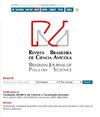肉鸡饲粮中棕榈油颗粒脂肪(颗粒脂肪和钙皂)替代传统植物油:生产性能和胴体性状
IF 1.1
4区 农林科学
Q3 AGRICULTURE, DAIRY & ANIMAL SCIENCE
引用次数: 0
摘要
本文章由计算机程序翻译,如有差异,请以英文原文为准。
Replacement of Conventional Vegetable Oil with Granulated Fats of Palm Oil (Prilled Fats and Calcium Soaps) in Broiler Chicken Diet: Performance and Carcass Traits
This study evaluated the productive performance and carcass characteristics of broiler chickens fed diets containing prilled fats of palm oil (PFPO) or calcium soaps of palm oil (CaSPO) replacing vegetable oils (VO). A total of two hundred 1-day-old male Ross 308 chickens were allocated in a 2 × 2 randomized factorial design. Diets included 2 PFPO levels (0 and 50%) and 2 CaSPO levels (0 and 50%). The level was the percentage of substitution of VO by granulated fats. The study had two phases (starter and finisher), each lasting 21 days. In the starter phase, PFPO did not influence (main effects; p >0.05) feed intake and body weight gain, but improved (main effect; p =0.03) feed conversion. In the finisher phase and the total study, PFPO had no effect ( p >0.05) on these productive variables. Throughout the study, CaSPO did not influence feed intake (main effect; p >0.50), but decreased weight gain and had a negative effect on feed conversion (main effects; p <0.05). There was no influence of fats (PFPO or CaSPO) on carcass yield, breast, drumsticks plus thighs, and wings (main effects; p >0.05). Chickens fed CaSPO had lower (main effect; p =0.02) carcass weight. The only PFPO × CaSPO interaction ( p =0.04) was for back yield. Results showed that PFPO or CaSPO could be employed in formulating broiler chicken diets, as they are less expensive than conventional VO. Partial substitution of VO for PFPO had minimal effect on productive variables, although partial dietary inclusion of CaSPO might slightly reduce the production of broiler chickens.
求助全文
通过发布文献求助,成功后即可免费获取论文全文。
去求助
来源期刊

Brazilian Journal of Poultry Science
农林科学-奶制品与动物科学
CiteScore
1.80
自引率
9.10%
发文量
60
审稿时长
>12 weeks
期刊介绍:
A Revista Brasileira de Ciência Avícola surgiu em 1999 a partir da necessidade que a comunidade científica possuía de um periódico para veiculação e publicação de seus trabalhos, com a publicação de três números anuais.
A Revista conta hoje com um corpo editorial altamente qualificado e com artigos científicos desenvolvidos pelos maiores especialistas da área, o que a cada dia atrai mais leitores em busca de inovação e respaldo técnico.
Devido à credibilidade que conquistou pelos esforços de sus autores, relatores e revisores, a Revista ganhou caráter de coleção, sendo consultada como fonte segura de estudo desenvolvidos na Avicultura.
A partir de 2003 – volume 5 -, a Revista passou a chamar-se Brazilian Journal of Poultry Science, e todos os trabalhos passaram a ser publicados em inglês. No mesmo ano subiu para quatro o número de revistas por volume, ampliando-se assim os trabalhos publicados anualmente.
 求助内容:
求助内容: 应助结果提醒方式:
应助结果提醒方式:


